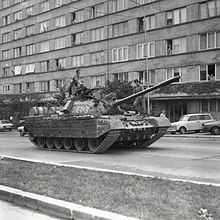Golaniad

The Golaniad (Romanian: Golaniada pronounced [ɡolaniˈada], from the word golan meaning "hoodlum") was a protest in Romania in the University Square, Bucharest. It was initiated by students and professors at the University of Bucharest.
The Golaniad started in April 1990, before the election of 20 May 1990, which was the first election after the Romanian Revolution. Their main demand was that former members of the Communist Party (4 million adults out of a total population of 22 million) should be banned from standing in elections.
Background
Ion Iliescu and Frontul Salvării Naţionale (FSN) seized power during the 1989 revolution. The FSN organization was meant to act as a temporary government until free elections were to be held. However, on 23 January 1990, despite its earlier claims, it decided to become a party and to run in the elections it would organize. A part of the dissenters and anti-communists that joined the FSN during the revolution (including Doina Cornea) left following this decision.
Many of the FSN personalities, including its president, Ion Iliescu, were ex-communists and as such the revolution was seen as being hijacked by the FSN.[1]
The FSN, which was widely known from the revolution and associated with it, won 66.3% of the votes, while the next party – the Democratic Union of Hungarians in Romania – obtained only 7.2% of the votes (followed by PNL 1- 6.4%, MER- 2.6%).
The protests

On 22 April 1990, the PNŢCD and other parties organised a demonstration in Aviators' Square. After the peaceful demonstration, groups of people marched towards the Romanian Television (TVR) station, calling for its political independence. They continued their protest in the University Square and decided to sit-in overnight. Two days later, they were still there, their numbers growing, on the evening of 25 April, their number reaching 30,000. Soon, the number of protesters reached 50,000 each evening.[2] They stated that they will not leave the Square until Romania would be free of Communism.
President Ion Iliescu refused to negotiate with the protesters and called them "golani" ("golan" meaning a hooligan, a scamp, a ruffian or a good-for-nothing — which later gave the protest its name) or legionnaires. The ending "-ad" ("-ada" in Romanian) was used ironically, since many of Ceauşescu's Communist manifestations had endings like this, for instance the annual national sporting event Daciad (in order to compare them either with an epic, like the Iliad or, rather, with the international Olympiad). The protesters also composed their own hymn, "Imnul Golanilor":
- Mai bine haimana, decât trădător
- Mai bine huligan, decât dictator
- Mai bine golan, decât activist
- Mai bine mort decât comunist"
- lyrics by Laura Botolan; music by Cristian Pațurcă
The song can be translated to English as:
- Better to be a tramp than a traitor,
- Better to be a hooligan than a dictator,
- Better to be a hoodlum than an activist,
- Better to be dead than communist"
Many intellectuals supported the protests, including writers like Octavian Paler, Ana Blandiana, Gabriel Liiceanu, Stelian Tănase and film director Lucian Pintilie. Eugène Ionesco supported them by sending a telegram from France in which he wrote he was a "Golan Academician" (Hooligan Academician).[3]
Their main three demands were the following[4]
- the eighth point of the Proclamation of Timișoara: leading members of the Romanian Communist Party and the Securitate not to be allowed to be candidates in the elections
- access to the state-owned mass media for all candidates, not only FSN candidates. A 1975 law of Ceauşescu (which was not yet repealed) allowed the president of Romania to directly control Romanian television and radio.
- postponing of the elections, since the only party that had the resources for the campaign was FSN.
The protesters also disagreed with the official doctrine of the FSN that the Revolution was only "anti-Ceauşescu" and not "anti-Communist" (as Silviu Brucan declared in an interview given to the British newspaper The Guardian). They also supported faster reforms, a true free market economy and a western-type democracy (Ion Iliescu argued for a "Swedish-style" socialism and an "original democracy", considering multi-party system as being antiquated[5]).
After the elections the protests continued, the main goal being the removal of the newly elected government.
Violent ending
After 52 days of protests, on 13–15 June, a violent confrontation with government supporters and miners from the Jiu Valley ended the protests, with many of the protesters and bystanders being beaten and wounded. Sources differ on the number of the casualties, the government confirming seven deaths related to the events.
See also
References
- ↑ România Liberă. "Iluziile au durat numai o lună. Au murit în zadar atâţia români ?" 25 January 1990
- ↑ România Liberă. "Nu plecăm acasă". 8 May 1990
- ↑ "Fenomenul Piata Universitatii 1990", Revista 22, May 12, 2003
- ↑ James Baker's speech in the US Senate, quoted by România Liberă, 19 May 1990
- ↑ Vladimir Tismăneanu, "Semnificaţiile revoluţiei române", Jurnalul Naţional
External links
- Scholarly article about the golaniad (in English)
- Article about the golaniad and third mineriad (in Romanian)
- Hymn of the Golans - Imnul golanilor MP3 audio
- 1990 election results
- discussion forum about Golaniad (in Romanian)